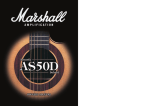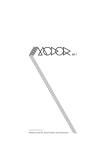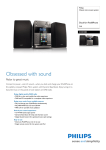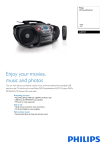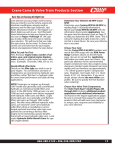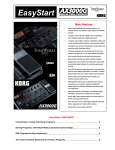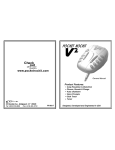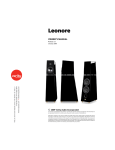Download OWNER`S MANUAL
Transcript
OWNER’S MANUAL FROM S L A S H Just like my live rig, the SL5 features a Celestion Vintage 30 speaker to give you that full, warm, midrange ‘bark’ that’s an essential part of the AFD tone. I hope you dig the SL5 as much as I do, it’s a blast to play. SLASH SIGNATURE 5 WATT COMBO Thank you for purchasing this SL5 Slash Signature, all-valve, 1x12" combo. Slash worked extremely closely with us in developing this amp and we know it will bring you countless hours of portable playing pleasure. “I use it at home as as a practice amp, and I also use it in the recording studio because it sounds so good.” Slash states. “The fact you can go from 5 Watts to 1 Watt makes it that much more flexible. I actually use the 1 Watt setting pretty regularly because it sounds and feels great, plus no one else can hear me when I’m practicing or noodling around.” Your SL5 contains one of the most highly acclaimed guitar speakers in the world – the Celestion Vintage 30. “When you add it to my Les Paul and my Marshall it’s just the perfect combination.” Slash explains. “This combo is something you can take anywhere… and it works! It’s not like a lot of amps that sacrifice a lot of sound just to be small. The SL5 is a mini AFD in a box!” Welcome to the Marshall family. ENGLISH To me the SL5 gives you the essence of the AFD100 in a portable, tube amp. Sure it’s small but it kicks *@#$in’ ass and the tones are 100% AFD. The thing is, as cool as it may seem on paper, it’s just not always possible or practical to have a Marshall half stack - let alone a full stack - in your bedroom or your house. The SL5 is perfect for that - plus recording, writing and warming up backstage too. You can carry it with one hand and if 5 Watts is too loud, you can switch it down to 1 Watt, crank it up and get that unique Marshall tube tone happening at a volume that won’t have your neighbors calling the cops! INTRODUCTION The Marshall Team Follow all instructions and heed all warnings. KEEP THESE INSTRUCTIONS. Warning: Before going any further, make sure that your amplifier is compatible with your electrical supply. If you have any doubt, please seek help from a qualified technician – your Marshall dealer can help you in this respect. Mains Input & Fuse: Your amplifier is provided with either a detachable mains (power) lead which should be connected to the mains input socket on the rear panel of the amplifier or a fixed mains (power) lead attached to the rear of the amplifier. The specific mains input voltage rating that your amplifier has been manufactured for is indicated on the rear panel of the amplifier. The correct value and type of mains fuse for valve amplifiers is specified on the rear panel of the amplifier. NEVER attempt to bypass the fuse or fit one of the incorrect value or type. Transporting your equipment: Please ensure that your amplifier is switched off and unplugged from the mains electricity supply and that all removable cables have been disconnected from your equipment before attempting to move it. Important set up information: 1. Make sure that the cabinet(s)/speakers, where appropriate, are connected to the correct impedance LOUDSPEAKER jack(s) on the rear panel of the amplifier. See the Speaker Output guides in this handbook, if applicable, for specific information regarding impedance matching. When using an extension cabinet make sure that you are using a proper speaker cable. Never use a screened (shielded) guitar cable for this purpose. WARNING! Failure to do any of the above may damage your amplifier. 2. Ensure that the VOLUME controls on the front panel are set to zero. 3. For amplifiers provided with a detachable mains (power) lead, connect the supplied mains (power) lead into the MAINS INPUT on the rear panel first and then into an electrical outlet 4. Plug your guitar into the INPUT jack socket on the front panel. 5. Turn the front panel POWER switch on and, if a valve amplifier, wait a couple of minutes before going to point 6. 6. Turn the volumes up to your preferred level and your amp is ready to play. This equipment has been tested and found to comply with the requirements of the EMC Directive EUROPE ONLY – Note: (Environments E1, E2, and E3 EN 55103-1/2) and the Low Voltage Directive in the E.U. EUROPE ONLY – Note:the average half-cycle r.m.s. inrush current, on initial switch-on, is 5.789 amps the average half-cycle r.m.s. inrush current after a supply interruption of 5 s is 4.557 amps 1 FRONT PANEL SLASH SIGNATURE 5 WATT COMBO VOLUME I GAIN TREBLE MIDDLE BASS II CLEAN 3 5 6 7 EQUALISATION 8 9 Note: The specific mains input voltage rating that your amplifier has been built for is shown on the back panel. Before connecting to the mains electricity supply, always ensure that your amplifier is compatible with your electricity supply. If you have any doubt, please get advice from a qualified technician. Your Marshall dealer will help you in this respect. Please ensure the amplifier is switched off and unplugged from the mains electricity supply before being moved. 10 POWER 11 12 13 14 15 16. POWER 7. OVERDRIVE GAIN This switch not only powers-up your SL5 (switch ‘down’), it also allows you to put in STANDBY mode (switch ‘up’). As is the case with all valve amps, the valves need a little time to warm up when the amp is first switched on, so STANDBY is 8. OVERDRIVE VOLUME REAR PANEL 6. Overdrive CHANNEL INDICATOR LED Glows red when Overdrive channel is selected. Controls the gain of the Overdrive channel. Controls the volume of the Overdrive channel. 16 useful for putting your amp into ‘idle’ mode during breaks in playing. IMPORTANT NOTE: You should also ALWAYS switch the amp to STANDBY whenever you switch between the 1 Watt and 5 Watt options on the rear panel. 9. TREBLE CONTROL Controls the high frequencies or top-end in your tone. INPUTS NOTE: Similar to vintage Marshall amplifiers, the SL5 has more than one guitar input. Input I is the high sensitivity input for the amplifier, traditionally this was used for guitars with lower output pickups. Many guitarists now take advantage of this input, which allows them to drive the amplifier harder as it provides +6dB more gain than the low sensitivity input. Which input you choose is purely down to personal taste and experimentation. 10. MIDDLE CONTROL Dictates the middle register of the amplifier. Turning up this control will make your guitar sound fatter. Conversely, reducing the amount of middle in your tone will result in a sharper and thinner guitar sound for a more ‘scooped’ tone. 11. BASS CONTROL Controls the amount of low frequencies or bottomend in your tone. 1. HIGH SENSITIVITY INPUT Traditionally used for guitars with low output pickups. Please experiment as suggested in the above Note. 12. REVERB SWITCH Turns the built-in Reverb on and off. 2. LOW SENSITIVITY INPUT 13. REVERB INDICATOR LED Traditionally used for guitars with normal output pickups. Please experiment as suggested in the above Note. Glows red when Reverb is selected. 14. REVERB CONTROL This control lets you add a lush reverb to the selected channel, from a subtle hint to cavernous and all points in between. 3. CLEAN VOLUME Controls the volume of the Clean channel. 4. CLEAN CHANNEL INDICATOR LED 15. PRESENCE Glows green when the Clean channel is selected. This control adjusts the power amplifier’s high frequency response, making your tone more cutting and ‘present’. 5. CHANNEL SWITCH Selects which channel is being used. It is overridden 2 1 2 3 4 5 1. Mains Input Socket with mains fuse 3. 8Ω Extension Speaker Output Jack Your amp is provided with a detachable mains (power) lead, which is connected here. The specific mains input voltage rating that your amplifier has been built for is indicated on the back panel. Before connecting for the first time, please ensure that your amplifier is compatible with your electricity supply. If you have any doubt, please get advice from a qualified technician. Your Marshall dealer will help you in this respect. The correct value of mains fuse located in the small compartment at the bottom of the mains socket is specified on the rear panel of the amplifier. The compartment also contains a space for a spare fuse. NEVER attempt to bypass the fuse or fit one of an incorrect value! NOTE: It is wise to carry spare fuses at all times. This is the output used to feed an 8Ω extension cabinet, a typical example being a Marshall 2x12". IMPORTANT NOTE 1: only one of the Extension Speaker Outputs can be used at once - so, if using an external 8 Ohm cabinet please unplug the internal speaker. IMPORTANT NOTE 2: NEVER use the SL5 unless the internal speaker or an external cabinet is attached correctly. 4. 16Ω Extension Speaker Output Jack This is where the internal 16 Ohm speaker is connected. If an external 16 Ohm cabinet, like a Marshall 4x12", is used, please switch the amplifier off before making the change. ALWAYS ensure you use a good quality speaker (unshielded) cable. 2. FOOTSWITCH 5. 5 WATT/1 WATT SWITCH By connecting the supplied 2 button footswitch (PEDL-00009) to this jack you can footswitch between the Clean and Overdrive channels, plus switch the Reverb on/off. The footswitch overides the front panel Channel & Reverb switches. This switch allows you to select either 5 Watt (switch ‘left’) or 1 Watt (switch ‘right’) output for your SL5. IMPORTANT NOTE: Please ALWAYS put your SL5 into STANDBY mode (via Power Switch on front panel) before switching between these two modes. 3 ENGLISH if the footswitch is being used. IMPORTANT: Read before powering-up STANDBY OFF ON SL5 OVERDRIVE 4 PRESENCE OD CLEAN 2 REVERB REVERB CHANNEL INPUTS 1 VOLUME




